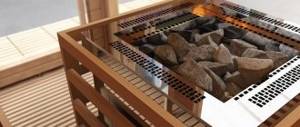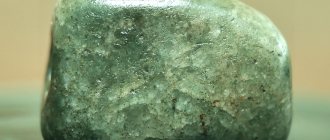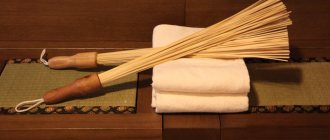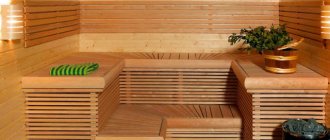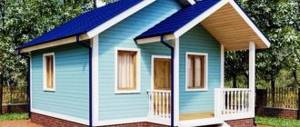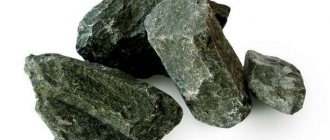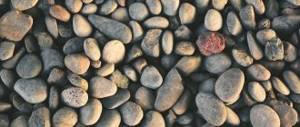Important Features
Let's start by highlighting what is most significant for a bathhouse. We want:
- so that the stone serves for a long time without or with minor replacement;
- so that for a long time after the stove is turned off, the heat that is essential for heating emanates from it;
- the bath heats up faster during operation of the stove ;
- so that health does not suffer from stones, but, on the contrary, improves.
- so that the stones are not too expensive (ideally, they are free))).
Different stones for a bath: which ones are better?
These are the requirements. Translating into the language of physics, we need heat-resistant , heat-intensive stones, with good heat transfer . Plus, of course, they are cheap and environmentally friendly . It would be optimal to choose those with all indicators above average. (By the way, ordinary water has the highest heat capacity; it is twice as high as that of brick for the same volume.)
Bath stones: which ones are better in terms of durability
There are two approaches: those rocks that last longer in the bath are those that are of igneous, deep origin and more or less alkaline composition (that is, the amount of silica is no more than 50%). But this is a good definition for geologists, and ordinary people are better able to navigate among the numbers. We will provide the corresponding sign, but we must warn:
IMPORTANT! The service life of a stone depends on so many factors that it is impossible to predict . The deposit, composition, impurities, type of stove, frequency of using the bathhouse, even the size and shape of the stones matter.
First of all, of course, the mineral composition of the rock and the heating temperature in the furnace . People far from geology believe that stones have the same composition if they are called by the same name. In fact, the mineral composition is variable , because the conditions of formation differ in some way. And there is much more, for example, the replacement affecting part of the production from the same field. Therefore, you need to look at specific samples.
However, here is the promised table, which allows you to very roughly estimate the heat resistance of the stone and the time it will live in the oven :
LONGEVITY TABLE
| Name | Term |
| Nephritis | 10 years |
| Jade | 4 years |
| Jasper | 2 years |
| Chromite | 5 years |
| Quartz | 3 years |
| Soapstone chlorite | 3.5 years |
| Dunit | 6 years |
| Quartzite | 4.5 years |
| Porphyrite | 5 years |
| Gabbro-diabase | 2 years |
| Cast iron | 6 years |
| Porcelain | 10 years |
As you can see, in terms of longevity, there are two candidates for the best stones for a sauna stove - jade and ceramic balls . We would also add here indestructible balls made of food-grade stainless steel . This trinity will really live for a long time in a sauna stove. But each of these materials will cost a pretty penny. (By the way, ceramics also vary in composition.)
Which stones are best for a steam bath in terms of heat capacity?
If you are not in a hurry when you are going to take a steam bath, then spare no time and firewood for the most heat-intensive stones. Here is a small table that lists not all, but many of the bath stones:
TABLE OF DENSITY, THERMAL CONDUCTIVITY AND HEAT CAPACITY
| Breed | Density g/cm³ | Thermal conductivity coefficient W/(m*K) | Specific heat capacity kJ/(kg*K) |
| Basalt | 2,6-3,25 | 0,4-3,5 | 0,5-2,1 |
| White quartz | 2,6—2,65 | – | 0,75 |
| Gabbro-diabase | 2,79-3,3 | 1,7-3,3 | 0,8-0,9 |
| Granite | 2,34-2,76 | 1,1-3,9 | 0,2-1,5 |
| Dolerite | 2,79 – 3,3 | see basalt, gabbro-diabase | see basalt, gabbro-diabase |
| Dunit | 3,28 | 1,1-1,9 | 0,6-0,8 |
| Jade | 3,25-3,35 | 2,3-3,6 | 0,88 |
| Raspberry quartzite | 2,68 | 2,6-7,6 | 0,7-1,3 |
| Jade (amphibolite) | 2,95-3,4 | 1,6-2,9 | 1,0-1,2 |
| Peridotite | 3,2-4,4 | 3,8-4,9 | 0,9-1,1 |
| Porphyrite | 2,67 | 0,7-3,5 | 1,6-1,7 |
| Rodingitis | 2,99 | – | – |
| Soapstone chlorite | 2,7-2,98 | 3,3 | 0,98 |
| Chromite | 4,5-5,0 | – | – |
| Jasper | 2,6 | – | – |
Again, the table clearly shows that the best stone for a bath in a steam room in terms of heat capacity is porphyrite. basalt into account due to the wide spread of values, but its relatives - dolerite and gabbro-diabase, although they do not have the same high heat capacity, are still more than competitive - they benefit due to their good heat capacity and low price .
You may also have noticed that the values are mostly around one - a little more, a little less, but there is no big scatter.
By the way, the same clay can, in certain conditions, accumulate heat in greater quantities than any bath rock - clay has values of up to 3.6 in the wet state (due to heat-intensive water). This means that the choice is always made simultaneously according to several criteria. Let's continue to consider them.
Stones for the stove in the bathhouse: which ones are better for health safety
This is not an idle question. First, let’s find out why bath stones can be dangerous in general. Firstly, radiation . Secondly, sulfides and other impurities , which burn out at high temperatures to form compounds harmful to humans. Thirdly, mechanical destruction, the result of which is fine dust , harmful to breathing.
Radiation
If a rock is formed at great depths in the mantle, then it will, in principle, not contain radioactive elements that are concentrated in the earth's crust. jadeite , dunite , and peridotite without any fear . All other breeds were formed higher in one way or another. But most of them do not pose any radiation hazard. The exception is granite, which may well have an increased background radiation. But, since it does not meet other characteristics, it can be forgotten.
Sulfides
Yes, this is an unpleasant “additive” to stone, which is often found in nature. There are many complaints about Karelian stones.
Sulfide decomposes at high temperatures, forming sulfur oxides, which form acids with water. Inhaling air containing sulfuric acid vapor is extremely undesirable for people.
Sulfides are easily identified visually - as gray and dark gray veins and spots with a metallic sheen or as golden crystals on the surface of the stone.
The photo gives an idea of what the sulfide may look like on the surface. But they are all dark gray with metallic. shiny or yellow, like pyrite. Photo source: Rosettes of Molybdenite, by subarcticmike's, licensed under CC BY
IMPORTANT! Follow the rule that the amount of sulfides on the surface of the stone should not be more than 5% of the total surface area. Of course, you will have to determine by eye, but still. If there are less than 5% of them, then they will simply burn out in 1-2 fires without a trace. Although it will be unpleasant, it will not last long.
Sulfides are the scourge of many stones ; there is no point in listing them, just be more careful when choosing.
Other impurities
Among other impurities we would include creosote and other substances of technogenic origin. The best from the point of view of their absence will be stones that were not paving stones or were not picked up near the railway or industrial facilities .
Dust
All stones are destroyed sooner or later, turning into sand and dust. Therefore, the heater needs to be cleaned regularly. As for soapstone, do not try to wash it clean - it tends to secrete talc and scaly chlorite, it will do this all the time it lies in the heater. Therefore, if you have a choice, then make it in favor of soapstone . Or just put other stones that don't generate dust. It is very good for finishing.
So, the best ones in terms of safety are certified stones without impurities.
Best stones by cost
Everything is simple here: better is cheaper. And gabbro-diabase remains the cheapest of the purchased stones.
We can quite reasonably recommend this particular stone, because it has suitable heat resistance and heat capacity. It is suitable for a heater due to two main characteristics. Whether it will collapse in 2 years, as the leaflet compiled by the sellers promises, or whether it will last 6-10 years depends on the case and type of stove, but this applies to all stones. Some people pick up pebbles in the forest and they last for 12 years; for others, jade does not last for a year. There are fakes and low-quality samples, but if the stone is cheap, then it is easy to replace.
Video on the topic
IMPORTANT! Complaints about the odor emitted by gabbro-diabase are complaints about sulfides . They are not always attached to the stone. Inspect samples before purchasing.
Well, you get the general idea, let's summarize what has been said.
White quartz
pros
- spectacular white color
- heats up quickly
- gives off heat well
- cools down slowly
- fragrant
Minuses
- when broken, forms sharp edges
- cannot withstand high temperatures
The vein rock breaks over time due to frequent temperature changes; you need to monitor the condition and replace it with a new one if cracks appear. Beautiful white color, looks impressive in combination with dark stones. It is believed that it produces ozone, which is why it is called hot ice, but no research has been conducted on this topic. It has only been proven that energy accumulates on the surface and a piezoelectric effect appears. Suitable for saunas that do not heat up very much (in fitness clubs, swimming pools).
What is the best stone for a bath?
There can be no definite answer here. We said:
- the most durable - jade, ceramics and stainless steel;
- the most heat-intensive is porphyrite;
- the safest are jadeite, dunite, peridotite (and all of them are not immune to sulfides, by the way)
- the cheapest is gabbro-diabase.
And if we add to this what the owners of saunas with heaters filled with jade say... The quality of the steam also matters, right?
Therefore, we are still forced to cheat a little and say a completely expected banality:
- if you have the financial opportunity , it is worth buying jade, jadeite, ceramics and stainless steel;
- if the bathhouse is budget , then it is better to opt for porphyrite, gabbro-diabase and dunite.
And, of course, you are free to mix stones - natural or artificial - at your discretion.
We do not recommend taking quartz, basalt, serpentine (serpentinite) , rodingite, granite and jasper.
Soapstone is better than soapstone because magnesite is more heat resistant than chlorite.
If our opinion is not enough, read user reviews and the rating (in the compilation of which, by the way, each of you can take part).
Soapstone chlorite
When heated, soapstone emits soft, comfortable warmth
This rock has a denser and more durable structure than diabase. Externally, soapstone bath stones are discreet, but interesting and have a variety of shades of gray.
The rock has good heat capacity and resistance to chemically aggressive environments.
The most important advantage of the stone is that it heats up extremely quickly. It accumulates 2.5 times more heat than a stove brick and releases it evenly and for a long time. This means that soapstone generates “light” steam.
Useful properties of soapstone:
Among the beneficial properties of the rock, it can be noted that when heated, it emits soft and comfortable heat, in the infrared spectrum, similar to the sun. It increases our immunity and normalizes metabolism.
When choosing which stones are suitable for a bathhouse, keep in mind that soapstone may generate dust. You will get rid of this drawback if you rinse and heat the stones before the first bath procedure.
The best stones for a bath: reviews
By the way, everything is always complicated with reviews on the Internet; it’s better to go for an experiment and trust your own feelings than to strangers writing for unknown reasons.
Let's take the same jadeite . There are many reviews about “the best stone in the world,” but if you analyze them, the main advantages are: the steam has become lighter, the smell is pleasant. No one was healed by the healing stone, threw away their crutches and started dancing.
And there is reason to think about whether a person gets the most pleasure from the money spent? Checking it is as easy as shelling pears: buy a box (20 kg) of high-quality jadeite, put it in the top layer and try the steam. And the toad will not strangle, and the impressions will be personal, not from words.
The best reviews are those indicating the brand of the stove, operating mode, duration and results. One of the users says that he had two stoves at his disposal: Angara 2012 and Compact .
The compact was loaded with a mix, the revision was carried out 4 years after loading. It turned out that the following rocks suffered the most: abbro-diabase and crimson quartzite. Soapstone chlorite produced the most .
The jadeite did not break at all, so the user loaded the new stove exclusively with jadeite - both into the open and closed heater. Two years later, I carried out the first inspection: in the open one, nothing happened to the stone, but in the closed one , it broke into small fragments about 1/5 of the entire backfill.
Other users are in no hurry to share such detailed information. Someone boasts that his gabbro-diabase from Karelia stood for 10 years, and during the inspection only a few broken stones had to be replaced, and a little sand had to be raked out.
Another steamer reports the absolutely fantastic survival of soapstone from the Onot talc deposit : the stone worked for more than three decades in different furnaces!!!
Sometimes stones found independently in nature also demonstrate good survival: one user enjoyed steam from forest stones , another reported the survival of pebbles from a neighboring field for 10 years.
From the examples given, it is clear that no one has used all the options, but considers the best stones for a bath to be those with which he has dealt.
On the other hand, in the reviews there is nothing contrary to the nature of the stone: if you do not heat it to the limit, do not “wash” it with an open fire, in which everything oxidizes at a terrible speed, then it will live in your stove happily ever after. And if the stove is intermittent, with an open fire, then you need to be prepared to frequently replace the contents of the heater.
Video
Listen to a professional's advice on choosing the best stones:
And here is a review from a simple user.
And if you agree that there is nothing better than your own experience, then maybe share it with us? We decided to invite all readers who have experience using different stones and have formed their preferences to vote in our rating of bath stones:
Raspberry quartzite
pros
- record low radiation levels
- Maintains room temperature for a long time
- beautiful colour
- is not destroyed by chemical reactions with liquids
- high hardness
- withstands temperatures up to 2700 degrees
Minuses
- Often there are copies with cracks in boxes
Very beautiful dark crimson color, withstands high temperatures, minimal radioactivity. Heats up quickly and gives soft warmth. According to reviews, it helps against respiratory and cardiovascular diseases. It consists of 93% quartzite, heats up smoothly, and releases heat evenly. Suitable for long-term use, often used in public baths. There are many copies with cracks, you need to control this when purchasing.
Rating
Don’t be shy, vote, your opinion will add objectivity to such an important issue for every vaper.
If you want to find out who is currently claiming the title of “the best stone for a bath,” select your option - the results will then open automatically.
*** We wish you to find the most useful stone or mix that gives the perfect steam for you and your guests. For more materials on stones, see the section page.
And when the best breed or mixture has been chosen, it’s time to read about placing it in a stove or electric heater.
Rules for choosing a quality mineral
When choosing stones for a bath, you should first study the information about what they should be. During the selection process, it is recommended to adhere to the following recommendations:
- the shape must be round and the surface smooth - all this contributes to good air circulation and heating;
- if the heater is small in size, then the selected rocks should be small;
- there should be no inclusions of other types of rock, mica and defects that will lead to rapid destruction;
- Before you start using stones, you need to first check them for cracks and chips.
As a test, it is recommended to heat the stone and place it in ice water - the rock should not split after this.
Advice! The ideal option is to select boulders whose size varies from 5 to 20 cm.
Briefly about the main thing
The main properties of stone for a bath are heat resistance, the ability to store heat and not absorb moisture, density and uniformity of structure.
- Jadeite is an expensive and rare stone that has a healing effect on the human body.
- Soapstone is a northern stone often used for saunas.
- Crimson quartzite is a beautiful brown stone that is resistant to high temperatures and produces high-quality steam.
To lay the heater, you can use gabbro-diabase, white quartz, sea pebbles, and basalt.
You can find some types of bath stones yourself. But you shouldn't do this on a railway embankment.
You need to place stones in the heater, placing them on the bottom. At the bottom there should be the most massive specimens and the most heat-resistant rocks.
It’s not enough to know how to choose stones for a bath; you also need to carefully care for them. Be sure to wash them and periodically replace damaged ones.
Ratings 0
Jade
Crushed and polished jadeite for baths
This semi-precious rock has an emerald or light green color and is not volcanic, but is a separate mineral.
In addition to their beautiful appearance, these stones for sauna heaters have the highest strength and service life (3 times longer than other types), low water absorption and high heat capacity. It is worth noting that jadeite stone for baths retains heat for a long time and generates very powerful steam. Jadeite is absolutely safe and environmentally friendly.
Jadeite colors range from light green to emerald green
Useful properties of jadeite:
Of its healing properties, the most important are the beneficial effects on the central nervous system, stabilization of blood pressure, cure of kidney and urinary tract diseases.
Geology
You can scroll through this section, but we explain in the clearest language what is meant by the name “porphyrite” in geology .
We are accustomed to the fact that the name is akin to a proper name, but in the case of porphyrite this is not entirely true. Rather, it is an indication of the structure that this or that rock has, formed not on the surface, but at a shallow depth beneath it. The structure is called "porphyry".
Porphyrite deposits. Photo by Porfirit LLC
It represents... “raisins” of formed crystals in a glass “roll”. Crystals are usually spars of one kind or another, except for one type: porphyrite should not contain potassium feldspar.
How is a “glass loaf” made? From the melt. Depending on the solidification conditions, the melt can solidify both in the form of crystals and in the form of amorphous (not having an ordered crystal lattice) glass. This glass is not identical to window glass, but the structure of both is amorphous. The higher the temperature and pressure (this is possible at depth), the more formed the crystals are; the faster the cooling and the lower the pressure (at the surface), the more similar the stone is to glass. In the middle (at a shallow depth) grains of the most easily formed crystals are formed, and the rest of the melt solidifies in the form of glass. This is what porphyrite is.
The composition of magma is different everywhere, the conditions of solidification are also different, so porphyrites are also different , with analogues in composition on the surface and at greater depths (it is clear that the same magma can solidify everywhere).
However, it is worth noting that long-term existence can lead to the fact that the volcanic glass in the porphyrite is replaced by of phenocrysts (large crystals, also known as phenocrysts) can also change
Effusive or intrusive?
Part of the difficulty in geology is related to the constant clarification and modernization of names. What was called “porphyrite” yesterday is no longer recommended for such a name today.
Photo Potential-Nedra
But we will explain: volcanic rocks that pour out lava onto the surface are called volcanic If this happened a very long time ago and they somehow changed during their existence, then they are called paleotypic, but if this happened by geological standards recently and they did not change, then cenotypic. In principle, this division applies not only to effusive rocks, but you will soon understand what's what.
Intrusive rocks are those igneous rocks that formed under the surface of the earth, at different distances from it in depth. If the depth is shallow, then these are hypabyssal rocks; if the depth is large, then they are plutonic.
So, both paleotypic effusive and cenotypic hypabyssal and until recently, both had the right to be called “porphyrites”. Now the “Petrographic Code of Russia” recommends calling only igneous hypabyssals . Therefore, the current porphyrite is intrusive, not effusive. And this is not one breed, as was said, but many.
Porphyry or porphyrite
Another interesting issue of terminological boundaries. It all started in ancient times, where “porphyry” was a crimson-colored stone . In Rome, this color was the color of rulers, hence the great value of this stone. It was characterized by large crystals of one color distributed in a homogeneous mass of another color. Moreover, the word “porphyry” itself is translated from Greek as “crimson.”
But over time, they began to pay less attention to color and more to structure . Thus, different rocks with phenocrysts of large crystals began to be called “porphyries” or “porphyrites,” and the structure itself became “porphyritic.” It turned out that most rocks with this structure are dark, dark gray, dark green, and only a few have a purple or red color.
In the end, at least in Russian petrography, the name “porphyry” was assigned to acidic rocks (that is, containing a lot of silicic acid), which contain large porphyrocrystals, and “porphyrites” began to be called rocks of medium and basic composition (with medium and low content silicic acids) also with large porphyrocrystals.
It can also be said that porphyries contain potassium feldspar and/or feldspathoids, while porphyrites do not .
Compound
The chemical composition is simple:
| SiO2 | 45-65 %, |
| Al2O3 | 15-18%, |
| Fe2O3 | 7-12,5%, |
| CaO | 3.5-10.5%, etc. |
With minerals it is more complicated: porphyrites include basic and medium rocks containing silica in an amount of 45 to 65%. Silica in the composition of porphyrite is represented by aluminosilicates as: plagioclase (andesine), pyroxene, hornblende . These rocks form phenocrysts (large crystals). In addition to them, there is also a main mass, which may consist of the same minerals of the second generation, as well as any other rock-forming materials, except for the already mentioned potassium feldspar and/or feldspathoids. For example, chlorite, biotite, and epidote are found.
There are many varieties of porphyrite. As an example, we will give the mineral composition of two varieties mined in Ukraine and Karelia.
Andesitic porphyrite can consist of 50-60% plagioclase, 20-30% chlorite, 8% epidote (another 2% impurities). In basaltic porphyrites, chlorite can predominate - 50-60%, the proportion of plagioclase is 40%, epidote - 6-10%.
